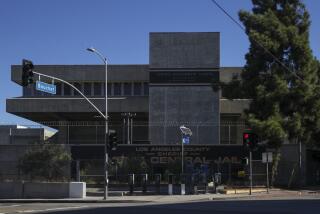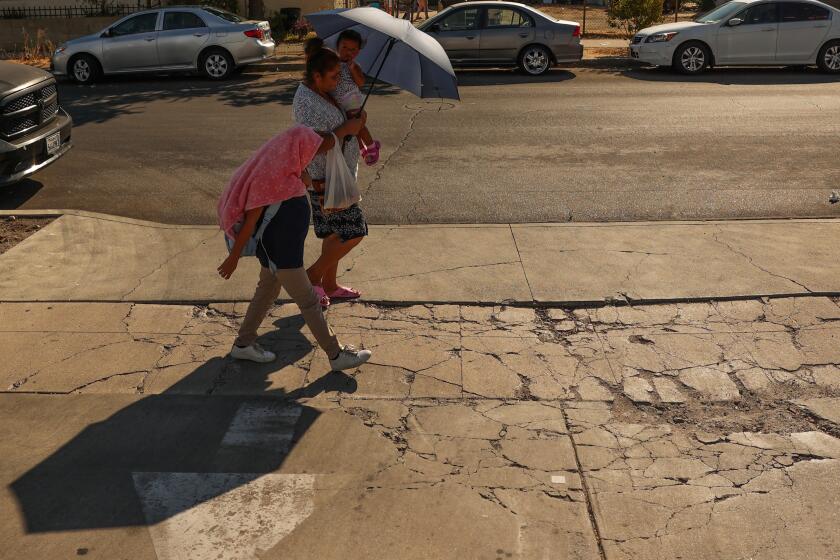Report Faults Design in CSUN Garage Collapse : Earthquake: Consultants dispute builder’s claim that structure was up to code, criticize system of construction.
The collapsed parking garage at Cal State Northridge, a widely displayed symbol of the destructive power of the Northridge earthquake, suffered from a “conspicuously flawed” design that failed to meet state building codes, concluded a report released by the university Monday.
The inch-thick report by Dames & Moore Inc., an engineering firm that researched the collapse for the school, criticizes the system under which construction work is done for state university campuses, saying it lacks adequate safeguards and reviews.
It also directly contradicts longstanding claims by the project’s Glendale-based builder that the $11.3-million project did comply with code requirements.
“It is Dames & Moore’s opinion that the design of Parking Structure C was not adequate, in fact that it was conspicuously flawed,” the university’s consultant concludes.
The report cites several possible scenarios stemming from inadequate construction to explain the collapse, saying it probably began with the failure of several interior vertical support columns.
The five-level, four-acre garage was the only structure on the heavily damaged CSUN campus to suffer a near total collapse in the Jan. 17, 1994, earthquake, which had its epicenter only about a mile and a half to the south.
A contractor hired by the university recently began demolishing the remains of the structure. University officials have said they do not plan to rebuild it.
Cal State officials commissioned the report in part to determine whether they had a case to sue A. T. Curd Builders of Glendale, the contractor that built the 2,500-space garage in 1990-91. But state university officials later said they did not expect to file such a lawsuit.
Reached late Monday, Andrew Curd, president of the company, said it was difficult for him to comment without having seen the report, but remarked: “We disagree completely. . . . That structure met or exceeded code in every case. The ground motion just wildly exceeded” the forces the codes anticipated.
Litigation over the collapse could prove embarrassing to university officials because, in a dispute over adequacy of the design, they previously sided with the builder over their own plan-check consultants.
Hired to assure that construction plans conformed to building codes, the consultants, Esgil Corp., said that Curd claimed a higher value for the structure’s ability to flex with earthquake shock waves than the design warranted.
But university officials sided with Curd after the firm provided letters from several engineering firms supporting its interpretation of the building code. Esgil then submitted a revised plan-check list that said its objections had been “resolved,” but one of the firm’s structural engineers still refused to sign off on the plans.
The Dames & Moore report criticized two key elements of the way in which Cal State officials handled the project: the decision to allow a “design-build” contract--in which the same firm oversees both aspects of the project--and the plan-check process, in which Esgil, the review firm, was brought in only after construction was about to commence.
The report urged the CSU system to “consider not using the design-build type of procurement for permanent university structures.” The report added: “It is our opinion that the advantages . . . may not be worth the price of potentially low quality designs that even in a moderate earthquake may fail.”
The report called on the Cal State system to “employ a true ‘peer review’ system, not just an ‘after the fact’ plan review (where the reviewer has limited ability to correct major conceptual design flaws).”
“Such an ‘afterthought’ plan review . . . is basically too little, and too late. There is far too much pressure on the reviewer to not find problems,” the report said.
In a concession to the builder, which likely would complicate any potential lawsuit, the Dames & Moore report conceded researchers failed to find “any clear, unambiguous deviations from ‘specific’ building code requirements . . .” And the report found no substantial faults with the workmanship or materials used.
Instead, it said, “there is a series of general provisions in the code which the designers of Parking Structure C apparently did not address” relating to the structure’s flexibility to withstand earthquakes. And it added: “A consistent failure to address a series of such provisions leads directly to a conclusion that not only the ‘intent’ of the code but the code itself was not complied with.”
Charles Thiel, Cal State Northridge’s chief building official and chairman of the Cal State system’s Seismic Review Board, a panel of experts that advise on seismic policies, said he doubted the school would sue over the collapse.
University administrators would probably have kept the report confidential if they wanted to use it in a lawsuit, he said. “You like to have your technical cards close to your vest.”
Thiel said that since the collapse the state university system has instituted peer review of all building projects from their inception, as the report urged.
The Dames & Moore report says the garage’s design did not make the outer walls of the structure strong enough to shield the interior columns from damage and/or did not make the columns themselves strong enough. The report also said the connections between the structure’s vertical and horizontal elements were “inadequate.”
When the interior columns failed, the floors of the parking structure fell and pulled inward the outer portions of the garage. That led to the unusual bent-over concrete columns that have appeared in photographs worldwide and, for many months after the earthquake, drew crowds of spectators to the campus to see the remains of the garage.
Among its other findings, the report downplayed the role of strong vertical earth movements from the quake being a major cause in the collapse, as A. T. Curd officials have long maintained. “Our findings are that failure could have occurred in the more critical elements without considering vertical ground motion,” the report said.
And the report said that the building’s problems could not be blamed on inadequacies in the code itself.
Finally, however, the report noted that the structural and seismic design of the project was consistent with prevailing construction practices. It blamed the “laxity” of those practices, more than code compliance issues, and the university system’s own procurement process in accepting them, for the garage failure.
More to Read
Sign up for Essential California
The most important California stories and recommendations in your inbox every morning.
You may occasionally receive promotional content from the Los Angeles Times.











